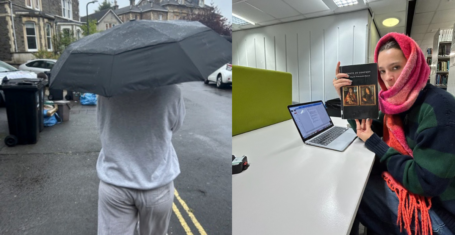
The (un)Taming of the Shrew with Edinburgh University Shakespeare Society
We spoke to director Minna Gillett ahead of opening night
Step into the world of The Taming of the Shrew – not William Shakespeare’s opulent Padua, of the Italian Renaissance, but Minna Gillet and the Edinburgh University Shakespeare Society’s (EUSS) White Lotus-esque poolside resort of the 1980s, premiering tonight at Pleasance Theatre.
You may think you have seen The Taming of the Shrew before, whether that be a traditionally-staged play, Franco Zeffirelli’s 1967 movie adaptation featuring Elizabeth Taylor, or the iconic ’90s take on the play 10 Things I Hate About You, but Minna spins it into a completely different direction.

What is The Taming of the Shrew?
It’s one of Shakespeare’s most famous comedies, set in Italy during the late 16th century. The original plot centres around Katherina, the titular shrew and her father’s plight to have her married off, so that his younger daughter, Bianca might also be given a chance by suitors.
Through various forms of torment and taunting (read starvation, sleep deprivation and suggested marital rape), Katherina is eventually “tamed” by a suitor named Petruchio. The play ends on a “happy” note, as the other male characters marvel at how Petruchio has managed to subdue Katherina into becoming the ideal wife.

How will this adaptation differ from Shakespeare’s original script?
The misogynistic themes of the play can be striking, especially for a 21st-century audience, and is something that in this adaptation, Minna specifically chose to write out of the script, moving away from the “taming” of an “outspoken person into quietness.”
Most Read
She says: “The most major cut is the last speech, seen as the most controversial, where Katherine (now Christian) talks about what duty a wife owns a husband. In my version it is gender neutral – what a partner owes a partner – and also have cut the more extreme statements about submission.”

Instead of leaning into the conquering of Katherine, she removed what she felt would only drive a misogynistic plot line and swapped the genders of many characters to undo certain conventions, including the main couple Katherina and Petruchio, now reimagined as Christian and Petruchia.
Minna explains: “We have this wonderful cast who really understood what my vision was, in terms of reducing this gendered element of the play […] and in a way its gender blind and sexuality blind.”
She instead chose to focus on the other themes – such as the setting of Padua being at the height of its wealth and that influence over the power dynamics. Instead of looking at how wealth affected early modern marriages, she instead explored the ways in which it played with ideas of “duty and responsibility; and the dynamics and rivalry between the younger and older generations.”
‘In the context of the relationship between the main couple, it makes more sense for the direction I have taken it – a more playful one about social power and charisma rather than gender. Hopefully the audience will see it as rounding off well the different part we have taken.”
Where was inspiration found for this adaptation?
Having only ever being on-stage in plays, working with EUSS for a number of years, Minna decided to step into the “creative, behind the stage position”, feeling the “urge to work with my own material [and] my own ideas on Shakespeare’s play.”
Minna pulled inspiration for this play from her year abroad in Bologna, Italy, which she describes as “a very similar setting to Padua [especially the] relaxing, drinking, sociable culture which is massively present in The Taming of the Shrew.”

“The experience of my year abroad brought inspiration in both content and setting. The pulls between pleasure, responsibility, ambition and relocation that are all instigated by the arrival to a new city – which happens both for the characters of Lucentio and Petruchia (Petruchio originally) – seemed to coincide strikingly with what I myself had just experienced.
“Then to bring all the sun and beauty I had soaked up in Bologna back to Edinburgh was a way to share back the time I sent away with the city I was returning to.”
This is seen in the set, created by the “incredible” Émilie Noël, Amalie Atfield and Matilda Bull, a pool resort owned by Minola, Katherina’s father. Whilst naturally there have been “issues” getting it all altogether, the crew have overcome them, creating a world of opulence and debauchery.
Minna explains: “Minola’s supposed to be a very wealthy merchant in Padua who now owns the resort that everyone is attending, that heightens the social atmosphere and sense of social coin and rivalry with other people, if you’re all based in this resort.”

Why watch the play?
Apart from the fact that Minna’s adaptation aims to deconstruct the patriarchal ideas of the original script, she hopes to bring a little bit of Italian warmth to us shivering Edi students. Minna wants to bring a “flush feeling of that warmth and lack of responsibility” that she felt on her year abroad to Edinburgh students who are at our “coldest and most stressed”. It is a “playful” production about “social power and charisma”, exploring “being young and going out into the world”, something all of us students are also experiencing for the first time as well.
“In terms of what I want people to take from it, mainly to just have a good time … I just had a year of really good time and want to bring that back to Edinburgh.”
If The Taming of the Shrew piques your interest, it runs from the 5th-9th February at Pleasance Theatre, with tickets starting at just £8 and available here.
Photos by Shirley Snow
Poster designed by Daisy Whittle


















